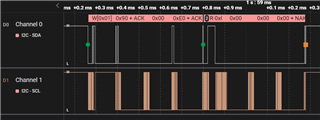Other Parts Discussed in Thread: MOTORSTUDIO
Hi there,
I noticed the Errata #8, that the I2C can't read registers when the motor is spinning. And I've verified this point, that once we wrote the DIGITAL_SPEED_CTRL (0xEC) to rotate the motor, the register can be written again, but neither did the motor execute the new speed command, nor did the register being read anymore.


But through Motor Studio, the GUI, it can successively control (0xEC) and monitor the motor (0xE2, 0xE0). And it doesn't have to write 0xEA to copy between shadow register and EEPROM. Therefore, I captured the waveform of their I2C communication, as shown below.


Could you please help me understand why I can't operate the EEPROM like Motor Studio? Thank you so much.


